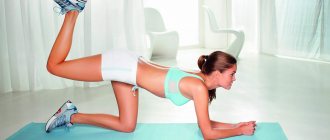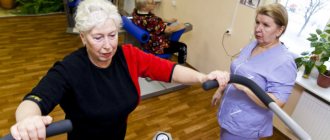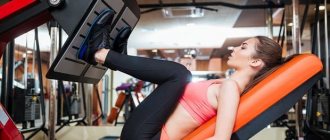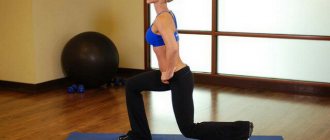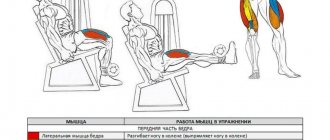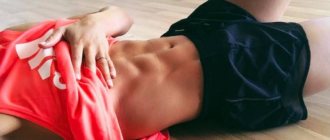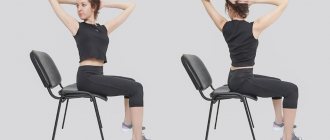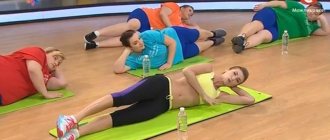Lying pelvic lift (legs on a chair)
This exercise uses the gluteal muscles in isolation.
What does the stand provide? After all, the exercise can simply be performed on the floor (without a stand).
A stand in the form of a chair, stool, or whatever allows you to make the exercise more difficult by increasing the range of motion. The greater the amplitude of movement = the more complex the exercise, which means the more benefit it will provide.
I recommend performing this exercise after the main butt exercises, such as squats, lunges, etc.
Another variation of this exercise looks like this:
Loop and cross
This exercise trains the lower body, back and abdominal muscles.
Execution order:
- Sit up straight with your knees together.
- Point your toes out, raise your arms and place them behind your head.
- Keeping your abs tense, bend your back slightly so that your shoulder blades touch the back of the chair.
- Cross your right elbow and left knee.
- Return to the starting position.
- Switch sides and repeat.
- Complete 20 reps.
Push-ups (feet behind on a chair/bench/etc.)
What does a footrest do for push-ups? Firstly, the exercise becomes harder (since the amplitude increases), which means there will be more benefit from it, and secondly, this variation shifts the emphasis more to training the chest muscles. In general, the pectoral muscles and triceps are actively involved in the exercise.
Additionally: front deltas, core muscles and abs. Detailed technique in the main article: “How to do push-ups correctly from A to Z.”
Jumping while sitting
Often the training process begins with jumping, which helps to stretch the whole body. But you can also do jumping jacks while sitting, which burns a lot of calories.
Execution order:
- Sit up straight with your knees together.
- Bring your knees together and raise your arms.
- Elbows should be bent and arms out to the sides.
- Your palms should face forward.
- Spread both legs out to the sides and flex your feet.
- Press into your heels and clasp your arms above your head like a regular jumper.
- Gradually return to the starting position.
- Perform 25-30 repetitions.
Chair push-ups
A lighter version of push-ups, because... the chair is usually not very wide in life, the position of the hands during push-ups will be quite narrow, which means the emphasis in this exercise will be more on the triceps.
I can’t really recommend this option to girls, it’s better to just do regular push-ups from the floor, or from the knees (if full push-ups are still difficult), where the placement of the hands will be neither wide nor narrow, but somewhere in the middle (shoulder-width apart). everything is involved evenly (both triceps and chest - this is what young ladies need).
But men can do regular classic push-ups and this option is of no use at all...
Leg raises and crunches
This exercise works your thighs, abs, and quadriceps.
Execution order:
- Sit on the edge of a chair.
- Start by stretching your right leg, remembering to lower your leg.
- Cross your arms over your chest and tighten your stomach.
- Rotate your torso to the right while raising your right leg toward your left knee.
- Squeeze your knees and return to the starting position.
- Repeat for the second side.
- Perform 15-25 repetitions.
Reverse push-ups
The exercise can also be performed with support on one leg:
One of my favorite exercises OUTSIDE of the gym (at home or outdoors) for TRICEPS.
I put my legs on another chair, so the exercise becomes harder and more effective. Read more in the main article: “Reverse push-ups.”
General recommendations for performing exercises with a chair
The activities presented below, although they have a direct connection with a chair, are unlikely to be sitting and relaxing. Doing exercises while sitting on a chair will require a lot of work. With such equipment it is much easier to lose weight, maintain physical fitness, and recover from injuries or illnesses. The main thing here is a reasonable approach and regularity, which only the lazy would not talk about.
Having only the most ordinary chair, you can train almost all muscle groups and perform a full range of exercises. The main thing is that your improvised sports equipment is not placed on wheels and is strong enough. You can check the last characteristic by resting your entire weight on your back.
Bulgarian lunges
A very cool and relevant exercise for all girls/women.
Lunges are the second exercise after squats, one of the most effective accentuated and indispensable exercises for the buttocks.
What does a rear footrest provide? Thanks to the stand, the angle of stretching of the buttocks increases (i.e., the buttocks will contract much more effectively). This implementation option is considered the most effective.
Detailed technique here: “Lunges for the buttocks, everything from A to Z.”
Running on a chair
This is probably the most fun cardio exercise on the entire list. Running on a comfortable chair may seem ridiculous to some, but this exercise has been proven to work your arms, abs, and legs. In addition, you can run on a chair even in heels.
Execution order:
- Sit up straight and stretch your legs.
- Your toes should point upward and your arms should be bent at your sides.
- Pull your stomach in and let your shoulder blades lightly touch the back of the chair.
- Bend your right knee and lift it towards your chest, lift your left shoulder towards your knee.
- Extend your right elbow back and switch sides.
- Do 25-30 quick reps.
Which older people should exercise while sitting?
A set of exercises while sitting on a chair for older people can have a specific therapeutic focus, and individual exercises or a group of them can be an integral part of an exercise with a general strengthening effect on the aging body. The sitting position allows you to perform almost all types of breathing exercises, and also, if necessary, perform exercises with objects: a gymnastic stick, a hoop, a ball, expanders, a rubber band, dumbbells.
To treat a disease, a complex of exercise therapy while sitting on a chair should be compiled by a doctor. For preventive and general strengthening exercises, his approval of the selection of exercises will also be more than appropriate, and will help prevent the development of undesirable consequences.
For example, if you have problems with the lower back, bending forward is prohibited, and almost all photos and videos of complexes for the elderly sitting on a chair posted on the Internet contain this exercise without any reservations.
Exercise therapy classes while sitting on a chair are prescribed for older people:
- after an acute period of illness and transfer to semi-bed rest;
- after heart attacks and strokes, with cardiovascular and pulmonary diseases, the severity of which does not make it possible to exercise while standing, as well as receive cardio exercises (do exercises in motion, walk, work on an exercise bike, swim);
- in the treatment of gout, arthritis and arthrosis;
- with severe diabetes with complications in the heart and legs;
- temporarily or permanently using a wheelchair.
Doing simple physical exercises while sitting on a chair and at a calm pace is recommended for very old people who, due to profound age-related changes, cannot move and are forced to remain in bed, but can still sit.
On a note. For those elderly who feel cheerful and regularly engage in physical exercise, special sets of exercises have been compiled, performed while sitting on a fitball, including with objects in their hands. Such activities help to diversify physical activity and, due to performing exercises in an unusual position, have a beneficial effect on the activity of the brain and the central nervous system as a whole.
If you are pre-diabetic or have diabetes, be sure to exercise with dumbbells
Contraindications
For performing exercises while sitting on a chair, as for any other therapeutic or “regular” physical education, there are both specific and general contraindications.
Please note that physical therapy and exercises while sitting on a chair are prohibited if:
- pathologies that prohibit sitting in a sitting position, for example, after operations or fractures of the spine in the lumbar and sacral region, after fractures of the hip joint or with degenerative-dystrophic changes in it;
- acute pain syndrome in any part of the body or internal organ;
- acute form of an infectious or cold disease;
- high arterial, intraocular or intracranial pressure;
- elevated body temperature;
- poor health, which, according to experience, can lead to the development of a heart attack or hypertensive crisis.
Advice. If you have coxarthrosis (damage to the hip joint) or when recovering from a hip fracture, do not sit for as long as possible, especially do not do exercise therapy while sitting on a chair. Such exercises are only available at the final stage of rehabilitation. Exercise lying down, on all fours or standing.
Examples of exercise therapy complexes while sitting on a chair
When choosing a set of exercises for older people, it is necessary to take into account the characteristics of the age category, health status and clearly understand the purpose of the exercise. Therefore, we provide examples of selections of exercises that can be performed without the consent of a specialist.
A set of exercises for weakened and very old people
It should be understood that it is very difficult for old and frail middle-aged and elderly people to study alone. Therefore, the presence of a relative nearby who would maintain a positive mood, and also count, set the rhythm and supervise the change of exercises, perhaps doing them together, is not just welcome, but necessary. It is advisable that during such a “training” music play that is pleasant for the practitioner.
The complex consists of 6 exercises, each of which must be done 10 times. They are so simple that they do not require much explanation; a photo gallery will suffice.
When making the complex, observe the following nuances:
- perform the exercises in the specified order;
- between exercises, do 2-3 cycles of diaphragmatic breathing - as you inhale, you should stick out your stomach, and as you exhale, pull it in;
- Do “bilateral exercises” not one by one, but in a row - 10 times in one direction, and then 10 times in the other.
1 – Raising your toes (heels on the floor)
2 – Heel lift (toes on the floor)
3 – Extension of one knee (possibly weighted on the ankles)
4 – Pull one knee to chest
5 – Leg abduction (hips tied with elastic band)
6 – stretching the elastic band in front of the chest (from a narrow grip position)
Tai Chi complex for elderly people using wheelchairs
Even older patients who temporarily or permanently use a wheelchair can practice Chinese health gymnastics. Adapted exercises from tai chi and qigong can also be performed on a regular chair. They are indicated for those elderly people who have problems with balance and cannot perform gymnastics for the elderly while standing.
On a note. During tai chi classes, according to the proposed video set of exercises for elderly people in a wheelchair, breathe calmly. Inhalations and exhalations should be shallow, smooth and long.
American Adaptive Chair Gymnastics for Seniors with Diabetes
For those retirees and older adults who have complicated diabetes, mobility and balance problems, diabetic foot disease, and neuropathy, the North American Council on Exercise (ACE) recommends the following set of physical adaptive exercises.
This selection is also suitable for those who are looking for exercises for older people with sore backs and legs:
| Image and title | Brief instructions |
| Sit up straight, straighten your back and neck. Lift your chin. Do not lean on the chair with your hands; they should be free along your body. Take several breaths of diaphragmatic breathing. Use it in the future, as rest breaks between other exercises, this or other complexes described below. |
| Walking while sitting with movements of the arms and legs should continue for a long time. The required aerobic effect occurs after 20 minutes of walking. Therefore, to make it easier, turn on appropriate music. For variety, periodically make movements with your hands that imitate boxing punches, uppercuts, and hooks. Watch the position of your back and neck. |
| Sit up straight, bring your feet together, bend your elbows, and bring your fists to your shoulders. As you inhale, simultaneously spread your arms up and to the sides, unclenching your fists and spreading your fingers, and spread your legs with emphasis on your heels. As you exhale, return to the starting position. You need to do the “Jumping Jack” for quite a long time – 10 minutes. When you feel tired, take short breaks. |
| Raise and bring your arms in front of you as shown in the figure. Don't forget about breathing. As you inhale, spread your arms, and as you exhale, bring them together. In the future, to enhance the effect, this exercise must be done with dumbbells, the weight of which will need to be gradually increased. The load dosage is at least 5 minutes, with pauses for respite and rest. |
The author of this complex, certified diabetic rehabilitation specialist Leanne Langdon, reminds that the source of health and the best drug for prolonging youth, which you don’t even need to buy, is regular and moderate exercise.
| Image and title | Brief instructions |
| Raising your arms up and stretching your back as much as possible, further stretch your back muscles, simulating moving your hands along a rope. Breathe randomly, shallowly and shallowly. Dosage – 3 cycles of movements until fatigue, with pauses for rest. |
| As a short break, as well as to prevent glenohumeral periarthritis and problems with the rotor cuff of the shoulder joints, make several (8-10) movements of your shoulders forward and then back. Move your joints slowly, matching your shoulder movements with your breathing. At the moment when your shoulders almost touch your ears, inhale, and at the lowest point, exhale. |
| In old age, you should not forget about such important joints as the wrist and ankle. First, make rotational movements in your wrists, and then, with each foot in turn, draw your last name, first name and patronymic in the air with your toe. As an auto-training, you can “write” with your sock not your full name, but motivational and therapeutic mottos. |
| The penultimate exercise suggests once again giving strength to the muscles of the back, abdomen and shoulder girdle. Sitting on an elastic rubber band, grab it by the ends. Raise your arms in different directions (up, forward, back, sideways, diagonally), thereby working different muscle groups. Raising your arms, inhale, returning to the starting position - exhale. |
After completing this complex of exercise therapy movements, take your time. Sit quietly for several minutes, periodically taking deep breaths and exhalations, raising and lowering your arms, making vibrating movements with them.
Complex “Chair Yoga for the Elderly”
Modern yoga therapy offers older people, who for certain reasons cannot fully practice yoga, to diversify their physical activity with the help of adapted asanas and poses performed while sitting on a chair.
The proposed video set of yoga exercises for the elderly is in English, but this does not prevent you from doing the exercises with an instructor. On the contrary, foreign speech will additionally stimulate brain function.
Exercise #4: Stepping onto a chair with a leg swing and lunge
A variation of the usual chair step.
Complicated but effective. The load is aimed at the muscles of the thigh, buttocks, and abdominal muscles. Execution technique.
Stand in front of a chair, feet shoulder-width apart. Lunge back with your left foot, push off with the heel of your right foot and rise onto the chair, stepping onto it with your left foot. Swing your right leg back, lower your foot to the floor and lunge back with your left leg again. Repeat 15 times and change legs. Perform 3-4 approaches.
During the swing, try to move your leg as far as possible while maintaining a straight body. This will further stretch the back of your thigh. To work your arms in this exercise, I advise you to take a 4-5 kg dumbbell in each hand and, while lifting onto a chair, alternately do biceps curls with a neutral grip (“hammer”).
